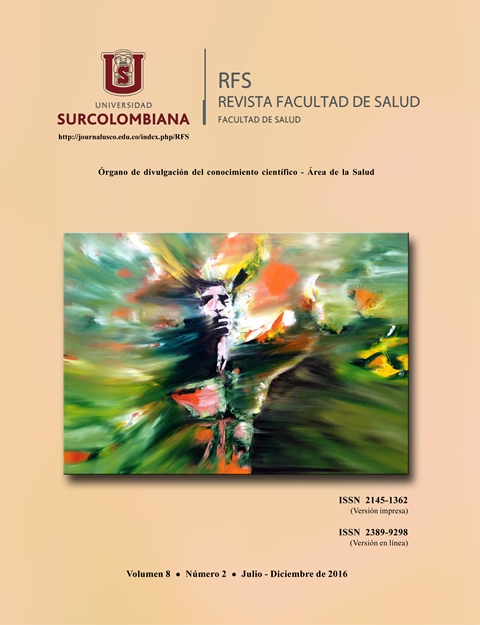Nasogastric tube insertion using esophageal guide in anesthetized patients at University Hospital in Neiva
##plugins.themes.bootstrap3.article.main##
The nasogastric tube insertion is a procedure that consists of introducing a polyvinyl probe through the nostrils, advancing it through the esophagus until it is located in the stomach. In patients under general anesthesia with orotracheal intubation, the insertion has a failure rate of up to 50% according to the technique in the first attempt. Situation that becomes a challenge even for experienced anesthesiologists. Objective. To evaluate the success rate and complications in the insertion of a nasogastric tube using an esophageal guide compared with blind digital technique. Materials and methods. Experimental study of a controlled clinical trial of two comparison groups, an experimental one of 19 patients (group A) in which the esophageal guide was used for the insertion of the nasogastric tube, and the other control of 21 patients (group B) with digital blind technique, in a period between the months of July and December 2012. Results: There were no significant differences between both groups (p> 0.5) in age, weight and height. The time used for probe insertion was significantly lower in group A with a mean in seconds of 70.89 seconds. The number of attempts in group A was much lower than in group B in 89.5% and 57.1% respectively for the 1st and 2nd attempts, while in the 2nd and 3rd attempts it was 10.5% and 42.9 %; the incidence of rolling in group A was significantly lower than in group B with 21.1% and 71.4% respectively. There were no complications in group A with the insertion of the probe compared to 3 cases in group B, without presenting severe complications in either of the two groups. Conclusions. The use of a guide for the passage of the nasogastric tube proved to be a practical and effective procedure that allows a procedure in less time when it is used in a patient under general anesthesia with orotracheal intubation. The number of attempts to pass nasogastric tube with guidance is much lower compared to the non-use of it. In addition, the deformations, which were mostly curled, occurred mainly when no guide was used, and the complications presented, nasal bleeding that only occurred in group B. Therefore, and according to the statistical analysis, the use of an esophageal guide is recommended for the passage of nasogastric tubes in an intubated patient.
Downloads
##plugins.themes.bootstrap3.article.details##
Gharib AM, Stern EJ, Sherbin VL, Rohrmann CA. Nasogastric and feeding tubes. The importance of proper placement. Postgrad Med. 1996 May;99(5):165-8, 174-6.
Phillips NM. Nasogastric tubes: an historical context. Medsurg Nurs. 2006 Apr;15(2):84-8.
Kirtania J, Ghose T, Garai D, Ray S. Esophageal guidewireassisted nasogastric tube insertion in anesthetized and intubated patients: a prospective randomized controlled
study.Anesth Analg. 2012 Feb;114(2):343-8.
Mahajan R, Gupta R. Another method to assist nasogastric tube insertion. Can J Anaesth 2005;52:652–3.
Kayo R, Kajita I, Cho S, Murakami T, Saito H. A study on insertion of a nasogastric tube in intubated patients. Masui2005; 54:1034–6.
Phillips NM, Nasogastric tubes: an historical context. Medsurg Nurs. 2006 Apr;15(2):84-8.
Gharib AM, Stern EJ, Sherbin VL, Rohrmann CA. Nasogastric and feeding tubes. The importance of proper placement. Postgrad Med. 1996 May;99(5):165-8, 174-6.
Hung CW, Lee WH. A novel method to assist nasogastric tube insertion. Emerg Med J. 2008 Jan;25(1):23-5.
Spurrier EJ, Johnston AM. Use of nasogastric tubes in trauma patients—a review. J R Army Med Corps. 2008 Mar;154(1):10-3.
Fuchs J, Schummer C, Giesser J, Bayer O, Schummer W. Detection of tracheal malpositioning of nasogastric tubes using endotracheal cuff pressure measurement.
Acta Anaesthesiol Scand. 2007 Oct;51(9):1245-9.
Hung CW, Lee WH. A novel method to assist nasogastric tube insertion. Emerg Med J. 2008; Jan;25(1):23-5.
Chun DH, Kim NY, Shin YS, Kim SH. A randomized, clinical trial of frozen versus standard nasogastric tube placement. World J Surg. 2009 Sep;33(9):1789-92.
Appukutty J, Shroff PP. Nasogastric tube insertion using different techniques in anesthetized patients: a prospective, randomized study. Anesth Analg. 2009 Sep;109(3):832-5.










